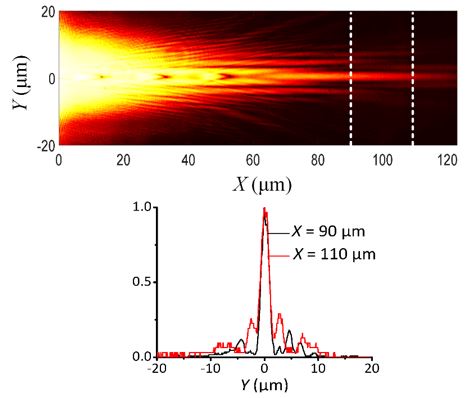Researchers from University of Science and Technology of China (USTC) realize diffraction-free Bloch surface wave in aqueous environment and in visible light band, which can be applied in optical nano-manipulation, imaging and sensing, such as assays involving DNA, proteins, and HIV, as well as a wide range of immunoassays.
Diffraction is ubiquitous for electromagnetic wave (including optical wave): the transverse dimension of a wave would expand during its propagation, and then the energy will disperse in the free space, which is not favorable for optical signals transportation or coupling. In the last decades, with the rapid development of nanofabrication technology and Plasmonics, various surface waves with diffraction free propagation have been proposed, such as the Plasmonic Airy beam, Cosine-Gauss Plasmon Beam and so on. But due to the intrinsic loss of the metal structures for these Plasmon beams, their propagating loss is very high, especially in the visible light band and aqueous environment. So, till now, there is no report on diffraction free surface wave in water. Whereas, the aqueous surrounding is essential for the applications of these beams, such as optical nano-manipulation, imaging and sensing.
To solve this problem, Associate Prof. ZHANG Douguo from USTC, collaborating with Prof. Lakowicz Joseph from University of Maryland School of Medicine, and the co-workers, have demonstrated that the diffraction free surface wave can be formed on a dielectric multilayer, named as the Diffraction free Bloch Surface Wave. Due to the low loss of the dielectric materials, this kind of waves can propagate as long as 110 micrometer and preserve the beam waist constant (about 2 micrometer). This surface wave propagating along the interface between the water and the multilayer, can be seen as an In-plane optical virtual probe. This work was published on Nature Communications.

Figure. Diffraction-free behavior of the wave can be preserved even after the wave encounters three obstacles: the beam waist keeps constant along all its propagation path. (Image by ZHANG Douguo)
Diffraction-free surface wave in an aqueous environment and in the visible light band is favorable for biological applications. Many biological and clinical assays are performed on glass surfaces, including assays involving DNA, proteins, and HIV, as well as a wide range of immunoassays. The ability to generate and control diffraction-free light waves on glass surfaces could have a large impact on the biosciences and result in other formats for diagnostic devices. Such applications are more difficult to achieve with metallic structures because of the high propagation losses at the metal/water interface. Owing to the low loss of BSWs, diffraction-free behavior can be preserved even after the wave encounters either three obstacles or a single mode silicon fiber along the propagation path. Due to these unique properties, this diffraction free Bloch surface wave will have practical applications in surface chemistry, surface physics, lab on a chip, optical manipulation, sending, imaging and so on.
Contact
Prof. ZHANG Douguo
dgzhang@ustc.edu.cn